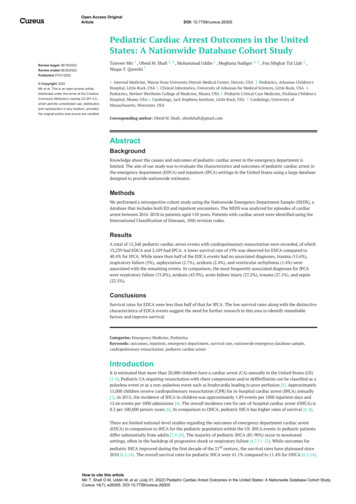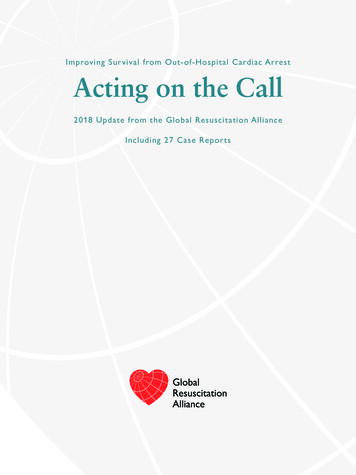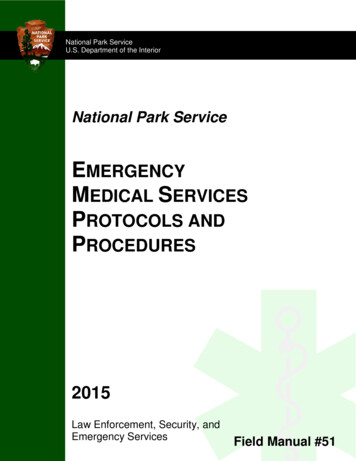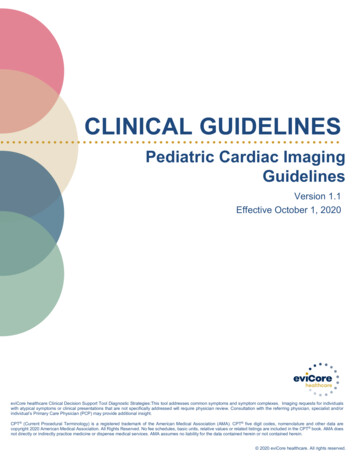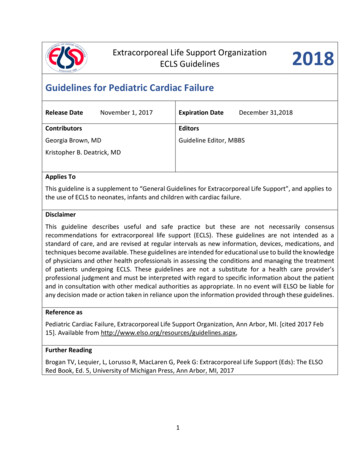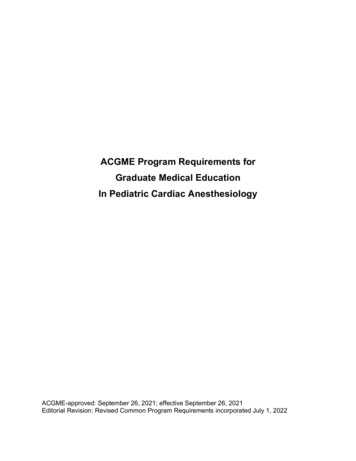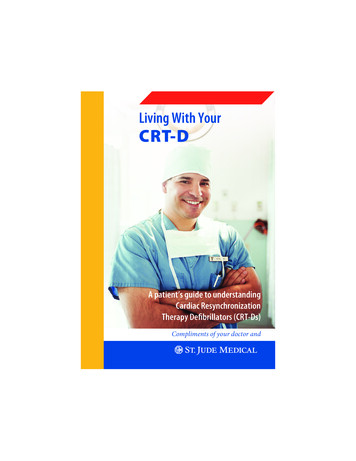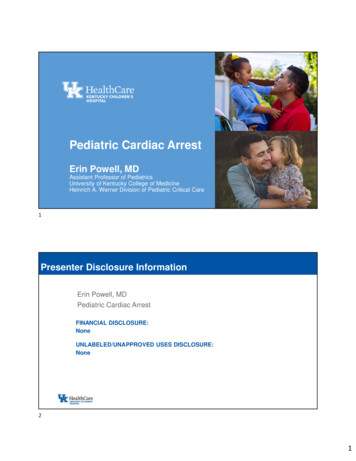
Transcription
Pediatric Cardiac ArrestErin Powell, MDAssistant Professor of PediatricsUniversity of Kentucky College of MedicineHeinrich A. Werner Division of Pediatric Critical Care1Presenter Disclosure InformationErin Powell, MDPediatric Cardiac ArrestFINANCIAL DISCLOSURE:NoneUNLABELED/UNAPPROVED USES DISCLOSURE:None21
Outline Epidemiology of Pediatric Cardiac Arrest Monitoring the effectiveness of CPR When conventional CPR fails Post-resuscitation care Outcomes3Epidemiology of Pediatric Cardiac Arrest Relatively uncommon compared with adult cases 16,000 children in the United States experience an OHCA each year 5,800 experience an IHCA each year 10-fold higher rate if cardiovascular disease. Higher rates in CICUs (4% to 6% of admissions) than in PICUs (2% to 4%) 2000 patients younger than 25 years will die from a sudden cardiac eventeach year in the United States42
Epidemiology of Pediatric Cardiac Arrest563
High Quality CPR1.2.3.4.5.Chest compression rateAppropriate depthFull recoil of the chestLimited time off the chestAvoid hyperventilationAbella BS. Circ 2005; 111:428-347High Quality CPR1.2.3.4.5.Chest compression rateAppropriate depthFull recoil of the chestLimited time off the chestAvoid hyperventilation84
High Quality CPR1.2.3.4.5.Chest compression rateAppropriate depthFull recoil of the chestLimited time off the chestAvoid hyperventilation9High Quality CPR1.2.3.4.5.Chest compression rateAppropriate depthFull recoil of the chestLimited time off the chestAvoid hyperventilation105
So how do we do? Chest compression qualitymetrics often do not meet2015 American HeartAssociation guidelines.Guideline compliance for rateand depth in children less than18 years is poor, with thegreatest difficulty in achievingchest compression depthtargets in younger children.(Pediatr Crit Care Med 2018;19:421–432)112015 PALS Updates Targeting a specific end-tidal CO2 (ETCO2) threshold to improve chestcompression technique Use of invasive hemodynamic monitoring during CPR to titrate to a specific systolic/diastolic blood pressure to improveoutcomes Reliability of intra-arrest prognostic factors to predict outcome126
2015 PALS Updates Targeting ETCO2 threshold Invasive hemodynamic monitoring Intra-arrest prognostic factors ETCO2 monitoring may be considered to evaluate the quality of chestcompressions, but specific values to guide therapy have not beenestablished in children. Minimizes interruptions of CPR for pulse checks If ETCO2 is 15 mm Hg, efforts should focus on improving CPR quality,particularly improving chest compressions and ensuring that the victimdoes not receive excessive ventilation.132015 PALS Updates Targeting ETCO2 threshold Invasive hemodynamic monitoring Intra-arrest prognostic factors For patients with invasive hemodynamic monitoring in place at the time ofcardiac arrest, it may be reasonable for rescuers to use blood pressure toguide CPR quality (Class IIb, LOE C-EO). Mean diastolic blood pressure 25 mm Hg during CPR in infants and 30mm Hg in children 1 year old was associated with 70% greater likelihoodof survival to hospital discharge and 60% higher likelihood of survival witha favorable neurological outcome.147
2015 PALS Updates Targeting ETCO2 threshold Invasive hemodynamic monitoring Intra-arrest prognostic factors Worse prognosis with OHCA, age less than 1 year longer durations of cardiac arrest presentation with a nonshockable rhythm Worse prognosis with IHCA,Martinez and Totapally. Resuscitation. 2016;105;177–181. age greater than 1 year longer durations15When conventional resuscitation fails ECPR Sustained or repetitive arrest events without ROSC for 20 minutes?Barbaro et al. ASAIO J. 2017 Jul/Aug;63(4):456-463.168
Pediatric CCPR vs. ECPR Age: 1 year for both groups Underlying diagnosis: E-CPR - surgical cardiac illness C-CPR - medical noncardiac illness First documented rhythm: E-CPR - PEA (41% versus 32%) C-CPR - bradycardia (49% versus 32%).17Post-resuscitation care Use of targeted temperature management to improve outcomes Use of a targeted Pao2 strategy to improve outcomes Use of a specific Paco2 target to improve outcomes Use of parenteral fluids and inotropes and/or vasopressors tomaintain targeted measures of perfusion such as blood pressure toimprove outcomes Use of electroencephalograms (EEGs) to accurately predict outcomes Use of any specific post–cardiac arrest factors to accurately predictoutcomes189
Post-resuscitation care Targeted temperature management Targeted Pao2 Targeted Paco2 Targeted measures of perfusion EEG Post–cardiac arrest factors No difference in survival with good functional with therapeutic hypothermiacompared to normothermia Fever (temperature 38 C or higher) should be aggressively treated afterROSC (Class I, LOE B-NR).19Post-resuscitation care Targeted temperature management Targeted Pao2 Targeted Paco2 Targeted measures of perfusion EEG Post–cardiac arrest factors Normoxemia (Pao2 60 mm Hg but 300 mm Hg) when compared withhyperoxemia (Pao2 300 mm Hg) after ROSC was associated withimproved survival to pediatric ICU discharge. Goal SpO2 94%, 100%2010
Post-resuscitation care Targeted temperature management Targeted Pao2 Targeted Paco2 Targeted measures of perfusion EEG Post–cardiac arrest factors Hypercapnia (Paco2 50 mm Hg) was associated with worse survival tohospital discharge. In other types of pediatric brain injury, hypocapnia is associated with worseclinical outcomes.21Post-resuscitation care Targeted temperature management Targeted Pao2 Targeted Paco2 Targeted measures of perfusion EEG Post–cardiac arrest factors Three small observational studies involving pediatric IHCA and OHCAdemonstrated worse survival to hospital discharge when children were exposedto post-ROSC hypotension. After ROSC, we recommend that parenteral fluids and/or inotropes orvasoactive drugs be used to maintain a SBP 5% for age. When appropriate resources are available, continuous arterial pressuremonitoring is recommended to identify and treat hypotension.2211
Post-resuscitation care Targeted temperature management Targeted Pao2 Targeted Paco2 Targeted measures of perfusion EEG Post–cardiac arrest factors EEGs performed within the first 7 days after pediatric cardiac arrest maybe considered in prognosticating neurologic outcome at the time ofhospital discharge but should not be used as the sole criterion.23Post-resuscitation care Targeted temperature managementTargeted Pao2Targeted Paco2Targeted measures of perfusionEEG Post–cardiac arrest factors Pupillary reactivity and lower lactate levels at 12-24h are associated withimproved survival. The reliability of any 1 variable for prognostication in children after cardiacarrest has not been established. Practitioners should consider multiplefactors when predicting outcomes in infants and children who achieveROSC after cardiac arrest.2412
Outcomes of Pediatric Cardiac Arrest Outcomes after OHCAs are better among children than adults, but stillpoor. 20% of children had ROSC prior to ED arrival ( 8% for infants to 35% foradolescents) 10% survived to hospital discharge and infants with lowest survival rates Survival did not improve from 2007-2012 Survival in children with an IHCA have improved significantly from 20002009 ( 15% to 35%-43%) 80% with a favorable neurological outcome Survival to hospital discharge is higher for surgical cardiac patients (37%-52%) thanmedical cardiac (28%-43%) or noncardiac (23%) patients25Outcomes of Pediatric Cardiac Arrest 29% of patients survived to hospital discharge 27% for C-CPR patients compared with 40% in theE-CPR group Favorable neurological outcome occurred in 18% ofthe C-CPR patients and 27% of the E-CPR patients Survival rates decrease over the first 15minutes of CPR, yet patients who received ECPR had no difference in survival across CPRdurations. Survival for patients receiving 35 minutes of CCPR was only 15.9% (compared to 15 minuteswas 44.1%). 25% of surgical cardiac patients survived todischarge after 35 minutes of C-CPR comparedwith only 10% of medical noncardiac patients2613
Thank you! And don’t do thiserin.powell@uky.edu27References Berg et al. Association Between Diastolic Blood Pressure During Pediatric In-Hospital Cardiopulmonary Resuscitation and Survival. Circulation. 2018;137:1784–1795. Marino et al. Cardiopulmonary Resuscitation in Infants and Children With Cardiac Disease. Circulation. 2018;137:e691–e782. Lasa et al. Extracorporeal cardiopulmonary resuscitation (E-CPR) during pediatric in-hospit.al cardiopulmonary arrest is associated with improved survival todischarge. Circulation. 2016;133:165-176. Barbaro et al. Pediatric Extracorporeal Life Support Organization Registry International Report 2016. ASAIO J. 2017 Jul/Aug;63(4):456-463. Martinez PA, Totapally BR. The epidemiology and outcomes of pediatric in-hospital cardiopulmonary arrest in the United States during 1997 to 2012.Resuscitation. 2016;105;177–181. Niles et al. Characterization of Pediatric In-Hospital Cardiopulmonary Resuscitation Quality Metrics Across an International Resuscitation Collaborative. PediatrCrit Care Med. 2018 May;19(5):421-432. de Caen et al. Part 12: pediatric advanced life support: 2015 American Heart Association Guidelines Update for Cardiopulmonary Resuscitation and EmergencyCardiovascular Care. Circulation. 2015;132(suppl 2):S526–S542. Abella BS et al. Quality of Cardiopulmonary Resuscitation During In-Hospital Cardiac Arrest. JAMA. 2005 Jan 19;293(3):305-10. Singal et al. Current and Future Status of Extracorporeal Cardiopulmonary Resuscitation for In-Hospital Cardiac Arrest. Can J Cardiol. 2017 Jan;33(1):51-60. Scheller RL, Johnson L, Lorts A, Ryan, TD. Sudden Cardiac Arrest in Pediatrics. Pediatr Emerg Care. 2016 Sep;32(9):630-6. Bembea et al. Outcomes After Extracorporeal Cardiopulmonary Resuscitation of Pediatric In-Hospital Cardiac Arrest: A Report From the Get With the GuidelinesResuscitation and the Extracorporeal Life Support Organization Registries. Crit Care Med. 2019 Feb 8. Moler et al. Therapeutic Hypothermia after In-Hospital Cardiac Arrest in Children. N Engl J Med 2017;376:318-29. Moler et al. Therapeutic Hypothermia after Out-of-Hospital Cardiac Arrest in Children. N Engl J Med 2015;372:1898-908. Fink et al. Unchanged pediatric out-of-hospital cardiac arrest incidence and survival rates with regional variation in North America. Resuscitation. 2016Oct;107:121-8.2814
Bembea et al. Outcomes After Extracorporeal Cardiopulmonary Resuscitation of Pediatric In-Hospital Cardiac Arrest: A Report From the Get With the Guidelines-Resuscitation and the Extracorporeal Life Support Organization Registries. Crit Care Med. 2019 Feb 8. Moler et al. Therapeutic Hypothermia after In-Hospital Cardiac Arrest in Children.
